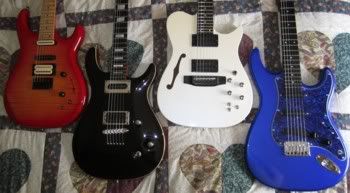Astronomy
Moderator: Priests of Syrinx
http://science.nasa.gov/headlines/y2006 ... list878803
May 30, 2006: Something remarkable is about to happen in the evening sky. Three planets and a star cluster are converging for a close encounter you won't want to miss.
The action begins at sundown on Wednesday, May 31st, when the crescent Moon glides by Saturn: sky map. You can see them side-by-side about halfway up the western sky, shining through the glow of sunset--very pretty.
Got a backyard telescope? Point it at the Moon. You'll see craters and mountains casting long shadows. Next, look at Saturn. The planet's rings will take your breath away. Also, look around Saturn. There's a star cluster! Saturn is sitting right next to "the Beehive," a swarm of stars 600 light years from Earth.
This three-way convergence marks a spot in the sky you should watch as June unfolds, because things are about to get even more interesting.
After May 31st, the Moon moves away, leaving Saturn and the Beehive behind. Keep an eye on Saturn every night. Before long you'll notice a dim red star approaching the ringed planet. That "star" is Mars. Every night it creeps closer to Saturn.
Fans of Star Trek, make the Vulcan "Live Long and Prosper" sign with your right hand. Hold it at arm's length. By Wednesday, June 7th, both Mars and Saturn will fit inside the "V"
Thursday, June 15th, is a special night. En route to Saturn, Mars will pass directly in front of the Beehive. Scan the ensemble with binoculars or a small telescope. Red Mars is about 16 times brighter than the surrounding stars. It'll look like a red supernova has gone off inside the cluster--a wonderful photo-op for amateur astronomers: sky map.
Not enough? In mid-June, Mercury leaps out of the glare of the Sun, soaring into the evening sky not far from Saturn and Mars. Greatest visibility occurs around June 15th, the same night Mars "explodes" in the Beehive. Mercury is easy to see even from over-lit cities.
Finally, the climax: On Saturday, June 17th, Mars and Saturn draw so close together you might think they're going to collide. (They won't.) Stick out your pinky and hold it at arm's length. The two planets will fit behind the tip with room to spare. Mercury, meanwhile, hovers just below. Wow!
Mark your calendar: May 31st, June 7th, June 15th, June 17th. Four sunsets, three planets and a star cluster--not a bad way to end the day.



- Devil's Advocate
- Posts: 927
- Joined: Mon Nov 17, 2003 2:42 pm
- Location: Pembs, Wales, UK
- Contact:
- Kares4Rush
- Posts: 3191
- Joined: Thu Nov 13, 2003 9:31 am
- Location: New York
STRANGE CLOUDS: Last night, sky watchers in Northern Ireland witnessed an intense display of electric-blue noctilucent clouds. Paul Evans took this picture from Larne, in Antrim County:
Noctilucent clouds (NLCs) are a mystery: They float through the outer reaches of Earth's atmosphere at the very edge of space. Some scientists think the clouds are seeded by space dust and fed by rocket exhaust. Others suspect they're a sign of global warming. Later this year, NASA plans to launch a satellite named AIM to investigate.


http://aim.hamptonu.edu/
Noctilucent clouds (NLCs) are a mystery: They float through the outer reaches of Earth's atmosphere at the very edge of space. Some scientists think the clouds are seeded by space dust and fed by rocket exhaust. Others suspect they're a sign of global warming. Later this year, NASA plans to launch a satellite named AIM to investigate.


http://aim.hamptonu.edu/



I heard there was suppose to be a comet-fly by the moon tomorrow but can't seem to find anything on it perhaps it is dooms day bawahahaheeheehoho 
At any rate here is a neat web page concerning celestrial happenings
http://www.arksky.org/index.php?pid=25
At any rate here is a neat web page concerning celestrial happenings
http://www.arksky.org/index.php?pid=25
When evil is allowed to compete with good, evil has an emotional populist appeal that wins out unless good men & women stand as a vanguard against abuse.

